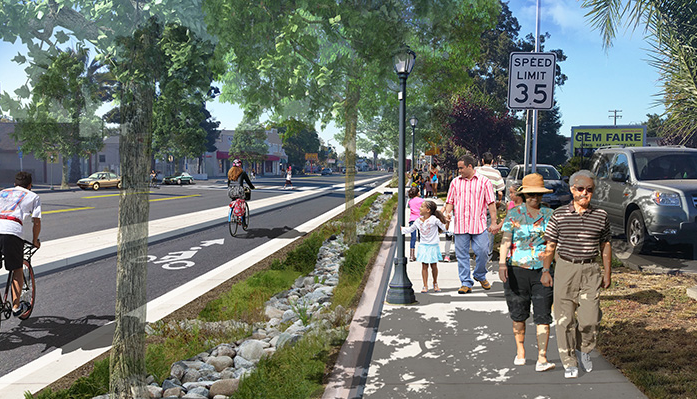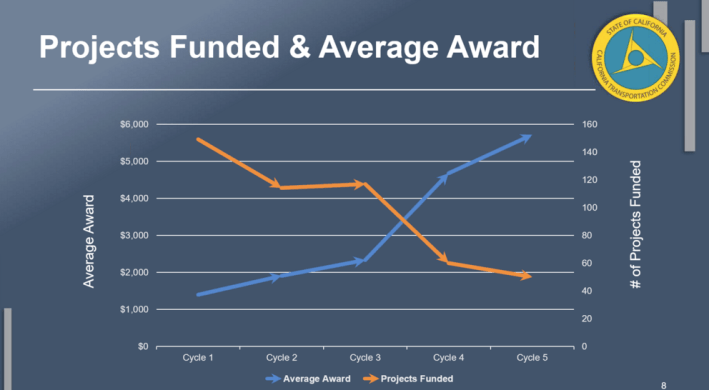Note: GJEL Accident Attorneys regularly sponsors coverage on Streetsblog San Francisco and Streetsblog California. Unless noted in the story, GJEL Accident Attorneys is not consulted for the content or editorial direction of the sponsored content.
California Transportation Commission staff has released recommendations for projects to fund under the current cycle of Active Transportation Program funding. The projects chosen are, on average, larger and more expensive than in past cycles. This means fewer projects in total receive grants from the limited funds available.
Forty projects were recommended under the Statewide competition, and another nine under the Small Urban and Rural competition. These 49 are out of a total of 454 applications for the current four-year funding Cycle 5.
All told, there were requests for $2.3 billion in ATP funding, and only $450 million total available, including the MPO competition which will be decided this summer. The average project cost is around $5.7 million, five times as much as the average cost of projects that applied for the first ATP funding cycle.
The projects selected include a mix of infrastructure and programming, with 29 considered Safe Routes to Schools projects. Every recommended project can show some benefit to a disadvantaged community.
Highlights
Highlights include the largest monetary award in the ATP's history, $31 million for "Connecting Canoga Park." This project will make improvements within the Canoga Park neighborhood in the San Fernando Valley, focusing on improving intersections and bike facilities. It will add a new Class IV bike path between the L.A. River Greenway and the Orange Line path, create enhanced crosswalks, and add urban cooling elements.
Other recommendations include $14 million for the Seventh Street Connection project in Oakland, in a neighborhood that had been hollowed out forty years ago by construction of BART and nearby freeways; and $9 million for the Franklin Boulevard Complete Streets Project in Sacramento.
Smaller projects recommended for funding include one to bring sidewalks to Biola, in Fresno County. This city is small, and the Post Office doesn't even deliver to residents, so everyone need to get to the post office to pick up their daily mail. The area lacks sidewalks, and has a low rate of car ownership. This project will bring the most basic of infrastructure to the city.
The Karuk Tribe in Siskiyou County is recommended to receive almost $10 million for its Happy Camp Complete Streets Project. The tribe had applied in a previous cycle, and this time around adjusted the scope of the project to better fit what they wanted to achieve. This is the third project funded on state tribal lands in the history of the ATP.
The complete project lists can be found at the ATP website. There is also a map available showing where the Cycle 5 recommended projects are located and giving details about each one.
Scoring
ATP projects are selected via a demanding process. Teams of two score every application, and each team then reviews the scores with CTC staff. The scoring rubric, the result of a long public planning process, includes separate scores on topics including benefits to disadvantaged communities, potential to increase bicycling and walking, potential to reduce collisions, and quality of public participation. Caltrans engineers also review the applications for feasibility and deliverability.
The projects recommended by staff all scored very highly, with the cutoff for the statewide competitive grants at 92 out of 100, and for the Small Urban and Rural projects at 90 points. Four of the projects in the latter category tied at ninety points, so a secondary ranking system was used to choose between those. This prioritized infrastructure projects, then project readiness, and then the potential to increase walking and biking.
More Funding Needed
The limited funding and trend towards larger projects means a lot of really good projects will not be funded this cycle. Some of the higher scoring ones that came in just below the cutoff - if they are located within any of the ten largest metropolitan areas - will have another chance later this year when the Metropolitan Planning Organizations propose projects. There is about $175 million available for those projects.
"We're excited about the projects that we're able to fund," said Laurie Waters, who is in charge of the ATP at the commission. "But I wish we could fund more."
Competition is fierce, especially as larger projects can sometimes show greater benefits. This can be discouraging to planners who put in a lot of time on the applications, including gathering public input on potential projects. But it has also been worth a second - or third - try. Fifteen of the projects recommended in Cycle 5 failed to get funding in the last round. These projects scored higher both because projects improved and because applicants did a better job explaining potential benefits.
Staff also held more then twenty workshops around the state, and conducted sixty site visits in thirteen counties and 32 cities.
Clearly more funding is needed for the ATP. While there are other funding sources for some kinds of active transportation or complete streets projects - such as the recent efforts to incorporate them into the SHOPP - the ATP is unique. It allows a broad range of entities to apply for funding, including small cities and school districts. It also includes funds for educational programming, which are needed to encourage people to try a transportation mode that might be entirely new to them.
At every recent CTC meeting, staff, commissioners, and even Caltrans have all noted repeatedly the need to expand the ATP's funding. However, so far there is no concrete proposal to do so, other than a push to include more cap-and-trade funding. This was done a few years ago, with a one-time enhancement of about $10 million that was quickly snapped up. It's also possible that a new federal reauthorization bill could increase the amount of funding available, especially under new DOT secretary Buttigieg, who is outspoken in his support for people who travel by foot, bike, and transit.
But what most needs to happen is a big shift in transportation investment strategies. The Active Transportation Program, as successful as it is, is a mere drop in the bucket compared to the larger investments California continues to make in expanding roads to make driving faster and more convenient.
These staff recommendations will be presented to the full California Transportation Commission for adoption in March. Find more information on the website here.







